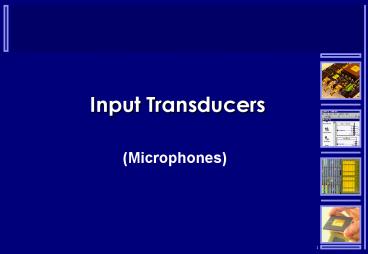Input Transducers - PowerPoint PPT Presentation
1 / 29
Title:
Input Transducers
Description:
Unidirectional (Cardioid) Primary pickup of sound from one side of the microphone's element ... Sound source. Cardioid Microphones. 29. Fin. Fin ... – PowerPoint PPT presentation
Number of Views:97
Avg rating:3.0/5.0
Title: Input Transducers
1
Input Transducers
- (Microphones)
2
Microphones
- Transducers that convert sound waves into
electrical signals - There are several different type of microphones
- Dynamic
- Condensing
- Carbon granule
3
Dynamic
- The diaphragm is moved by changing sound pressure
- This moves the coil, which causes current to flow
as lines of flux from the magnet are cut
4
Dynamic
- Advantages
- Rugged
- Inexpensive to manufacture
- Tolerates extremely high sound pressure levels
- Requires no power supply
- Disadvantages
- Reduced high frequency performance
- Needs amplification
5
Condensing
- A pair of parallel metal plates separated by an
insulator across which is stored an electrical
charge - QCV
- Moving the plates will change the voltage across
them causing current to flow in or out of the
capacitor through the resistor
6
Charging the Condensing Mic
- The microphone must have some means of charging
the plates - Battery
- Phantom powering
- Electret
- The majority of serious recording work is carried
out with capacitor microphones
7
Condensing
- Advantages
- No coil and the diaphragm can be made very thin
(few microns thick) thus light weight and less
inertia so better high frequency response. - Capacitor microphones can be made with virtually
any response pattern. - Disadvantages
- More complex thus more expensive
8
Carbon Granule
- When acoustical pressure is exerted on the carbon
granules, the granules are pressed closer
together which decreases the measured resistance.
9
Pickup Patterns
- Microphones can also be classified by their pick
up patterns - Omnidirectional
- Unidirectional
- Bidirectional
10
Omnidirectional
- Pickup of sound equally well within a 360 degree
radius around the microphone element
11
Omnidirectional
- Advantages
- Doesn't have to held directly in front of sound
source to pick up adequate sound - Gives a sense of the environment
- Is not affected by slight changes in
mic-to-source distance - Provides a natural sound in rooms with good
acoustics - Is less susceptible to handling noise and noise
created by wind or popping - Is not subject to the proximity effect
12
Omnidirectional
- Disadvantages
- Difficult to use in noisy locations
- Susceptible to feedback in locations where
microphone is feeding a loudspeaker
13
Unidirectional (Cardioid)
- Primary pickup of sound from one side of the
microphone's element - Wide angle cardioid
- Supercardioid
- Hypercardioid
14
Unidirectional
- Advantages
- Discriminates against unwanted sound
- Reduces danger of feedback in locations where
microphone is feeding a loudspeaker - Picks up very little or no background sounds
15
Unidirectional
- Disadvantages
- May be subject to the proximity effect
- Must be set correctly to avoid sound source being
off-mic - Less natural sound in rooms with good acoustics
- Must take care to avoid covering ports
- More susceptible to wind, popping and handling
noises
16
Bidirectional
- Optimum pickup of sound from two sides of the
microphone element - Advantage - can be used to reduce number of mics
in a circuit when two voices are involved in an
interview or performing a voice-over - Disadvantage - no separate control over levels of
talent, so they must maintain proper
mic-to-source distance and remain on-mic
17
Proximity Effect
- The closer the sound source is to the microphone,
the greater the emphasis on the bass frequencies
in the sound - Many microphones are equipped with a bass
roll-off switch to nullify the proximity effect
18
Condenser Frequency Response
19
Dynamic Frequency Response
20
Impedance
- One important characteristic of a microphone is
its output impedance - This is a measurement of the AC resistance
looking back into the microphone - Low (50-1,000 ohms)
- High (5,000 ohms)
21
Low Impedance
- Most microphones used in broadcast applications
are wired for low-impedance circuits - Low-impedance circuits have three wire
connectors a shield and two other wires (hot and
cold) to conduct the current
22
Balanced Systems
- Balanced lines are much less susceptible to RFI
(Radio Frequency Interference) and the pickup of
the other electrical noise and hum - In a balanced line, the shield of the cable is
connected to ground, and the audio signal appears
across the two inner wires which are not
connected to ground
23
Balanced Systems
- Output signal is split into two opposite phases
- Positive and Negative or Hot and Cold
- When returned to the same phase at the amplifier
input noise is cancelled.
24
Phantom Powering
- The standard power supply for microphones is 48v
- DC power is supplied along the signal leads,
which means no extra cables
25
Connectors
- Two types of connectors are commonly used with
balanced systems
26
High Impedance
- High-impedance circuits have two wire connectors
a shield and one inner wire - Used in budget systems
- High impedance makes the signal more susceptible
to electromagnetic interference - Signal is affected by cable capacitance in long
runs of cables
27
Feedback
- Feedback occurs when the sound from the
loudspeaker arrives at the microphone as loud or
louder than the sound arriving directly from the
original sound source (talker, singer, etc.)
28
Microphones and Stereo Signals
- Coincident or XY pair
- Right hand microphone picks up sound form left
stage and visa a versa - No phase problems as minimal space between
microphones
Sound source
Cardioid Microphones
29
Fin
- Fin































